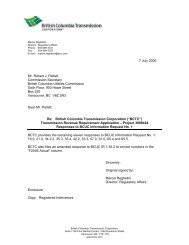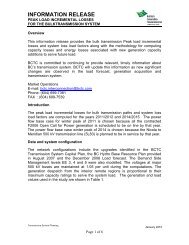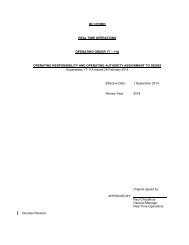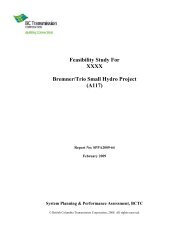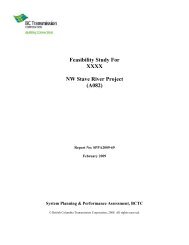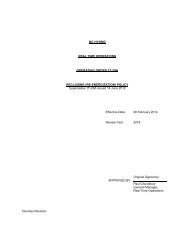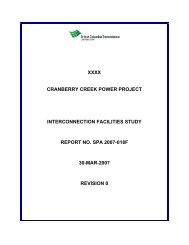Evidence on the Adequacy of First Nations Consultation - BC Hydro ...
Evidence on the Adequacy of First Nations Consultation - BC Hydro ...
Evidence on the Adequacy of First Nations Consultation - BC Hydro ...
You also want an ePaper? Increase the reach of your titles
YUMPU automatically turns print PDFs into web optimized ePapers that Google loves.
The first trading post in Ktunaxa territory was established close by <strong>the</strong> Columbia River by David<br />
Thomps<strong>on</strong> in 1807 near present day Windermere, B.C. and called Upper Kootenay House. 26 This<br />
appears to have been both for its nearness to Howse Pass and for what he perceived as good trade<br />
possibilities. Subsequently, regi<strong>on</strong>al posts for trading with <strong>the</strong> Ktunaxa and o<strong>the</strong>r Indian nati<strong>on</strong>s were<br />
established at Fort Colvile, Thomps<strong>on</strong>’s River [Kamloops], Spokane and Fla<strong>the</strong>ad al<strong>on</strong>g with<br />
numerous smaller outposts.<br />
It appears that <strong>the</strong> locati<strong>on</strong> <strong>of</strong> <strong>the</strong>se trading posts had important impacts <strong>on</strong> <strong>the</strong> activities <strong>of</strong> <strong>the</strong><br />
various tribal groups. For <strong>the</strong> Upper Ktunaxa, <strong>the</strong> posts at Kootenae House, Spokane and Fla<strong>the</strong>ad<br />
drew <strong>the</strong>ir attenti<strong>on</strong> southwards. For <strong>the</strong> Lower Kootenay, Sinixt and Okanagans, Fort Colvile was a<br />
powerful attractant. While most <strong>of</strong> <strong>the</strong> neighbouring Shuswap looked westward to Thomps<strong>on</strong>’s Fort,<br />
we shall see that some were deliberately attracted by <strong>the</strong> Huds<strong>on</strong> Bay Company towards Jasper’s<br />
House, east <strong>of</strong> <strong>the</strong> Rockies which brought <strong>the</strong>m into <strong>the</strong> traditi<strong>on</strong>al nor<strong>the</strong>rn range <strong>of</strong> <strong>the</strong> Ktunaxa.<br />
Catholic missi<strong>on</strong>aries like Fa<strong>the</strong>rs Blanchet and De Smets, called by <strong>the</strong> Indians “black robes”, began<br />
to proselytize in <strong>the</strong> area in <strong>the</strong> 1830s and 1840s and established a number <strong>of</strong> missi<strong>on</strong>s. They were at<br />
first received with an almost messianic fervour by <strong>the</strong> Plateau Indians, but this fervour appears to<br />
have subsided markedly in <strong>the</strong> later 1800s. According to Larry Cebula 27 , <strong>the</strong> Indians slowly realized<br />
that <strong>the</strong> white man’s Christianity was not c<strong>on</strong>ferring <strong>the</strong> spiritual power <strong>the</strong>y initially thought it<br />
would, especially regarding immunity to <strong>the</strong> horrifying and deadly diseases that c<strong>on</strong>tinued to plague<br />
<strong>the</strong>m.<br />
The character <strong>of</strong> <strong>the</strong> area began to change even more dramatically with <strong>the</strong> settling <strong>of</strong> <strong>the</strong> border with<br />
<strong>the</strong> United States through <strong>the</strong> signing in 1846 <strong>of</strong> <strong>the</strong> Oreg<strong>on</strong> Treaty in 1846, <strong>on</strong>e result <strong>of</strong> which was<br />
to sever Ktunaxa territory roughly in half. The impact <strong>on</strong> <strong>the</strong> western neighbours <strong>of</strong> <strong>the</strong> Lower<br />
Ktunaxa, <strong>the</strong> Salish speaking Sinixt, was even more dramatic in that new border restricti<strong>on</strong>s and<br />
aggressive settlers caused <strong>the</strong>m to eventually aband<strong>on</strong> <strong>the</strong> Canadian porti<strong>on</strong> <strong>of</strong> <strong>the</strong>ir traditi<strong>on</strong>al<br />
seas<strong>on</strong>al round and remove southward into <strong>the</strong> U.S. to settle <strong>on</strong> <strong>the</strong> newly created multi-tribal<br />
Colville Reservati<strong>on</strong>. This new reality also occasi<strong>on</strong>ed <strong>the</strong> 1855 Lame Bull Treaty, in which <strong>the</strong><br />
American based Blackfeet were reduced to a M<strong>on</strong>tana reservati<strong>on</strong> and peaceful access to <strong>the</strong><br />
dwindling buffalo herds was made available to <strong>the</strong> American Ktunaxa and o<strong>the</strong>r tribes in <strong>the</strong> U.S. 28<br />
The latter half <strong>of</strong> <strong>the</strong> 19 th Century saw <strong>the</strong> decline <strong>of</strong> <strong>the</strong> fur trade and <strong>the</strong> arrival <strong>of</strong> first a trickle and<br />
<strong>the</strong>n a flood <strong>of</strong> settlers into <strong>the</strong> Kootenays, primarily miners and farmers. Largely in resp<strong>on</strong>se to <strong>the</strong><br />
sudden influx <strong>of</strong> thousands <strong>of</strong> American gold prospectors, <strong>the</strong> Crown Col<strong>on</strong>y <strong>of</strong> British Columbia<br />
was created in 1858, and was eventually combined in 1862 with its counterpart <strong>on</strong> Vancouver Island.<br />
The col<strong>on</strong>ial government saw as its prime c<strong>on</strong>cern <strong>the</strong> attracti<strong>on</strong> <strong>of</strong> new settlers who pr<strong>of</strong>essed loyalty<br />
to <strong>the</strong> British Crown, and not <strong>the</strong> protecti<strong>on</strong> <strong>of</strong> Indians in <strong>the</strong>ir traditi<strong>on</strong>al lands, an orientati<strong>on</strong><br />
str<strong>on</strong>gly reinforced by <strong>the</strong> Chief Commissi<strong>on</strong>er <strong>of</strong> Lands and Works, Joseph Trutch. Under his<br />
26 This post was closed after a few years and subsequently replaced by <strong>the</strong> Huds<strong>on</strong>’s Bay Company with a small post to<br />
<strong>the</strong> south in <strong>the</strong> Tobacco Plains area known as Kootenae House. The initial clerk in charge was Edouard Berland, who<br />
was succeeded <strong>on</strong> his untimely death by Michael Phillipps who in turn subsequently became <strong>the</strong> first Indian Agent for <strong>the</strong><br />
Kootenay District. The post was closed for ec<strong>on</strong>omic reas<strong>on</strong>s in 1871<br />
27 Cebula, Larry, Plateau Indians and <strong>the</strong> Quest for Spiritual Power, 2003<br />
28 Traditi<strong>on</strong>al hostilities between <strong>the</strong> Blackfeet and o<strong>the</strong>r tribes c<strong>on</strong>tinued in Canada throughout <strong>the</strong> 1860s but <strong>the</strong>ir<br />
intensity mirrored <strong>the</strong> vanishing buffalo herds until both had virtually disappeared by 1880.<br />
15<br />
Page 159 <strong>of</strong> 200






